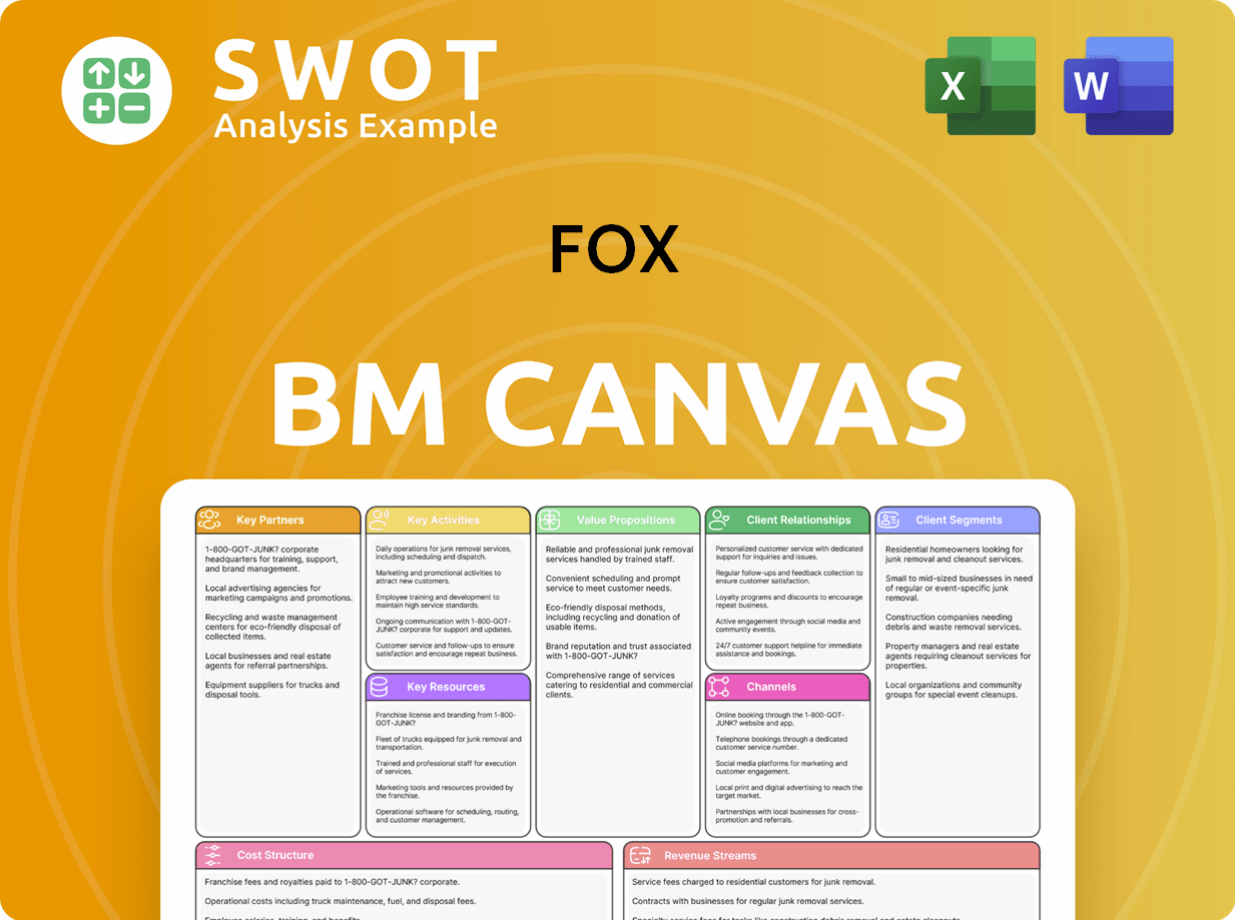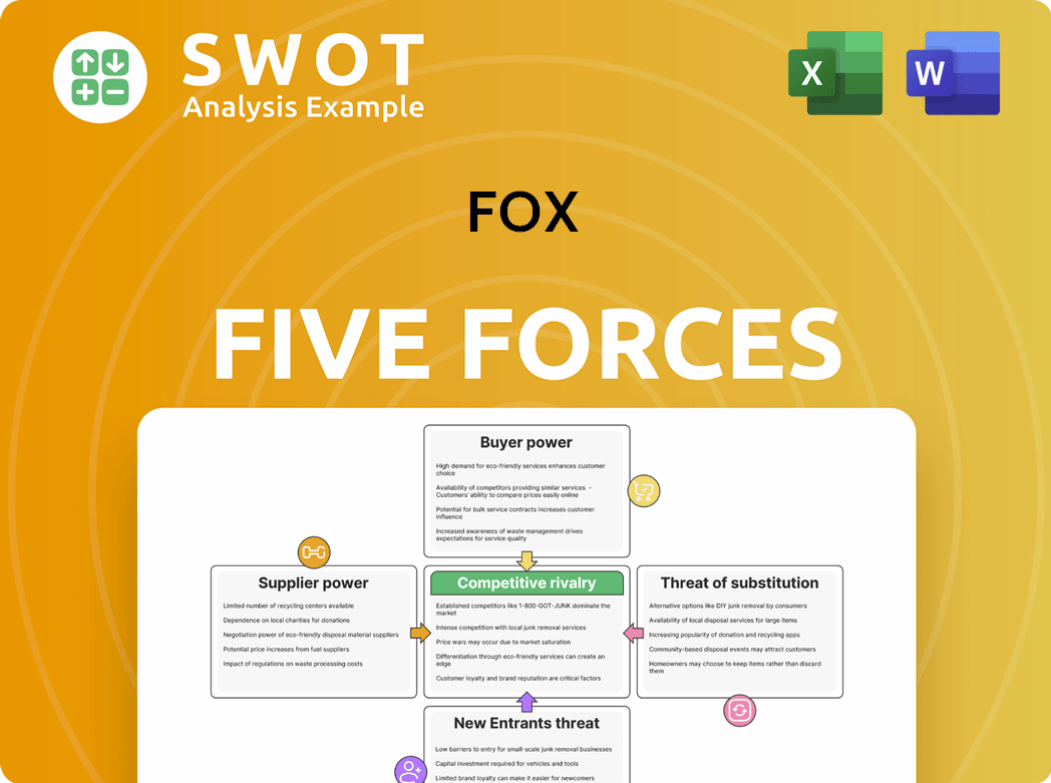Fox Bundle
How Does Fox Corporation Thrive in Today's Media Wars?
In the dynamic world of media, where consumer habits shift at lightning speed, understanding the Fox SWOT Analysis is crucial. Fox Corporation, a major player in the global media landscape, has strategically focused on live news, sports, and unscripted entertainment. This strategic pivot has allowed Fox to concentrate on core strengths in broadcasting and cable network programming, distinguishing itself from more diversified entertainment conglomerates.

Delving into the Fox Company competitive landscape reveals a complex web of rivals and strategies. This analysis will explore Fox Corporation competitors, examining their strengths and weaknesses to provide a comprehensive Fox business analysis. Understanding media industry competition is vital for investors and strategists alike, as we assess Fox market share and conduct a thorough competitive analysis Fox to uncover key insights.
Where Does Fox’ Stand in the Current Market?
Fox Corporation maintains a distinct market position within the U.S. media industry. Its focus is on live news, sports, and unscripted entertainment. This strategic concentration allows it to compete effectively in a rapidly changing media environment. The company's ability to secure and broadcast major sports events and deliver consistent news coverage are key differentiators.
The company's competitive strategy emphasizes its core competencies. By divesting from scripted entertainment and international assets, Fox has streamlined its operations. This focus allows for greater agility and adaptability in response to market shifts. The company's financial performance reflects the success of this strategy, with strong revenue streams generated from its core content offerings.
Fox's primary market is the United States, where its broadcasting and cable networks have extensive reach. Its strength lies in its ability to attract large live audiences. This is crucial for commanding premium advertising rates. Understanding the Growth Strategy of Fox helps to understand how it is positioned in the market.
Fox News Channel consistently leads in viewership within the cable news segment. This leadership provides a stable revenue stream and a significant platform for audience engagement. The channel's ability to attract and retain viewers is a key factor in its market position. Its strong ratings in early 2024 demonstrate its continued dominance.
Fox Sports holds a prominent position in sports broadcasting. Securing rights to major events like the NFL, MLB, and NASCAR is critical. These events attract large live audiences and command premium advertising rates. This positions Fox strongly in the competitive landscape of sports media.
The Fox network is a key player in reaching broad audiences across the United States. It is a key component of the company's overall strategy. This segment contributes significantly to the company's revenue and market presence. The network helps to maintain a strong position in the media industry.
Fox has strategically shifted its positioning by focusing on live content. This is less susceptible to competition from streaming services. This allows Fox to maintain strong financial health. The company's ability to monetize its core content effectively is a key strength.
Fox's strong position in news and sports broadcasting enables a leaner, more focused operation. This allows for quicker adaptation to market changes. The company's financial performance in fiscal year 2024 reflects its market standing.
- Competitive analysis Fox reveals a focus on live content.
- Fox market share is significant in cable news and sports.
- Fox Corporation competitors include major media conglomerates.
- The company's strategy supports its Fox business analysis.
Fox SWOT Analysis
- Complete SWOT Breakdown
- Fully Customizable
- Editable in Excel & Word
- Professional Formatting
- Investor-Ready Format

Who Are the Main Competitors Challenging Fox?
The competitive landscape for Fox Corporation is defined by intense rivalry across its core segments: news, sports, and entertainment. The company faces challenges from both traditional media giants and emerging digital platforms, which constantly reshape the media industry. Understanding the competitive dynamics is crucial for assessing Fox's market position and future prospects. A thorough Revenue Streams & Business Model of Fox analysis provides a foundation for evaluating its competitive strategies.
In the news sector, Fox competes directly with major players like CNN and MSNBC, while in sports broadcasting, it contends with ESPN, CBS Sports, and NBC Sports. The entertainment segment sees Fox Entertainment competing with other broadcast networks and streaming services. These competitors continuously vie for audience share, advertising revenue, and the acquisition of valuable content rights, making the competitive environment dynamic and challenging. The media industry competition is fierce.
The competitive landscape is further complicated by mergers, acquisitions, and the rise of digital media. These factors influence Fox's strategic decisions and its ability to maintain and grow its market share. The company must adapt to changing consumer habits and technological advancements to stay competitive.
Direct competitors in the news sector include CNN (Warner Bros. Discovery) and MSNBC (NBCUniversal, Comcast). These networks compete for viewership and influence, often battling over breaking news and political commentary. The competitive analysis of Fox includes assessing the performance of these rivals.
Fox Sports competes with ESPN (The Walt Disney Company), CBS Sports (Paramount Global), and NBC Sports (NBCUniversal). They engage in intense bidding for sports rights, crucial for attracting audiences and advertisers. The competitive advantages of Fox Corporation in sports depend on its ability to secure and retain these rights.
Fox Entertainment competes with ABC, CBS, and NBC for advertising revenue and audience share. Streaming giants like Netflix, Amazon Prime Video, and Max also indirectly compete for audience attention and advertising dollars. Fox's position in the entertainment industry is influenced by these factors.
Digital-native news outlets and social media platforms serve as primary news sources for younger demographics, posing indirect competition. The competitive landscape in the digital media space requires Fox to adapt its strategies. The rise of digital media is a key competitive threat to Fox Corporation.
Ongoing consolidation in the media industry reshapes competitive dynamics, creating larger, more integrated rivals. These mergers and alliances impact Fox's ability to compete effectively. The strategic decisions of these competitors influence Fox's market share.
Viewership battles among news networks are a regular feature of the media landscape, with shifts in audience share reported quarterly. The fluctuations in Fox's market share are closely watched. Fox's market share in cable news is a key performance indicator.
Several factors drive the competitive landscape for Fox Corporation. These include securing valuable content rights, attracting and retaining audiences, and adapting to the digital media environment. The company's financial performance is also crucial. Fox's key performance indicators compared to rivals are critical in this analysis. The competitive positioning of Fox news is also an important factor.
- Content Rights: Securing major sports leagues' broadcasting rights (e.g., NFL, NBA) is essential for attracting audiences and advertisers. Recent negotiations for NFL media rights highlight the intense competition.
- Audience Engagement: Competing for viewership and influence in the news sector, with slight shifts in audience share often reported quarterly.
- Digital Adaptation: Addressing the challenge from digital-native news outlets and streaming services, which are increasingly popular among younger demographics.
- Financial Performance: Assessing Fox's financial performance compared to competitors is crucial.
- Strategic Alliances: Navigating the impact of mergers and acquisitions in the media industry.
Fox PESTLE Analysis
- Covers All 6 PESTLE Categories
- No Research Needed – Save Hours of Work
- Built by Experts, Trusted by Consultants
- Instant Download, Ready to Use
- 100% Editable, Fully Customizable

What Gives Fox a Competitive Edge Over Its Rivals?
The competitive advantages of Fox Corporation are significantly shaped by its strategic focus on live content, brand equity, and extensive distribution networks. A deep understanding of the Marketing Strategy of Fox reveals how these elements work together to maintain its market position. Fox News Channel, a key component, benefits from strong brand recognition and loyalty, allowing it to attract substantial advertising revenue and maintain a dominant market share in cable news.
Another critical advantage lies in its robust distribution network. This network includes traditional broadcast television affiliates and widespread cable carriage agreements. This broad reach ensures that Fox's content is readily accessible to a vast American audience. Furthermore, Fox's strategic emphasis on live content—news and sports—provides a unique competitive edge. Live programming is highly resistant to ad-skipping and benefits from strong audience engagement, making it particularly attractive to advertisers.
Fox's ability to secure and retain rights to premium live sports events, such as its continued partnerships with the NFL, is a testament to its strategic investment in content that commands high value. These advantages are sustained by ongoing investment in content acquisition, technological infrastructure for seamless broadcasting, and strategic marketing efforts that reinforce its brand identity. While the media landscape is dynamic, Fox's concentration on these core strengths has allowed it to maintain a resilient competitive posture.
Fox Corporation has consistently invested in premium content, particularly live sports and news, to maintain its competitive edge. This includes securing long-term rights deals with major sports leagues. Fox News Channel has maintained its position as a leading cable news provider, consistently achieving high viewership ratings.
Fox has focused on expanding its digital presence while maintaining its traditional broadcast and cable networks. The company has strategically positioned itself to capitalize on the growing demand for live sports and news content. Fox has adapted to the changing media landscape by investing in digital platforms and streaming services.
Fox's competitive edge is rooted in its strong brand equity, particularly with Fox News and Fox Sports. The company's focus on live content, which is less susceptible to ad-skipping, attracts advertisers. Fox's extensive distribution network ensures broad audience reach, a critical advantage in a fragmented media market.
Fox News consistently ranks among the top cable news channels in terms of viewership. Fox Sports holds significant market share in sports broadcasting, benefiting from major league partnerships. The company's financial performance, including advertising revenue, reflects its strong market position.
Fox's strengths include its strong brand recognition and focus on live content. Its extensive distribution network provides a broad reach to audiences. However, the company faces challenges from declining traditional TV viewership and increasing competition from streaming services.
- Strengths: Strong brand equity, especially in news and sports; extensive distribution network; focus on live content.
- Weaknesses: Reliance on traditional TV, which is declining; competition from streaming services; potential for political polarization.
- Opportunities: Expansion into digital platforms and streaming; further monetization of live sports rights; diversification of content offerings.
- Threats: Cord-cutting; increased competition from streaming giants; changing consumer preferences.
Fox Business Model Canvas
- Complete 9-Block Business Model Canvas
- Effortlessly Communicate Your Business Strategy
- Investor-Ready BMC Format
- 100% Editable and Customizable
- Clear and Structured Layout

What Industry Trends Are Reshaping Fox’s Competitive Landscape?
The media industry's competitive landscape is currently in a state of flux, driven by technological advancements and shifting consumer behaviors. These changes present both hurdles and opportunities for media giants like Fox Corporation. Understanding the current industry trends, potential future challenges, and emerging opportunities is critical for assessing Fox's strategic positioning and future prospects. A comprehensive Brief History of Fox can provide further context.
The transformation toward digital platforms and streaming services is a key trend, as audiences increasingly move away from traditional linear television. This shift impacts revenue streams and requires media companies to adapt their distribution models and content strategies. Regulatory changes and the rise of AI-driven content creation also pose significant challenges. However, the enduring demand for live news and sports content, a core focus for Fox, creates unique advantages.
The media industry is witnessing a significant shift towards digital and streaming platforms, with audiences increasingly consuming content on-demand. This fragmentation of audiences and the decline in traditional linear TV viewership are key trends. The rise of AI in content creation and personalization is also reshaping production and distribution strategies. The competitive landscape is intensifying due to these shifts.
A primary challenge for Fox is maintaining revenue streams from traditional broadcast and cable amid the shift to digital platforms. Competition for advertising revenue is increasing, requiring innovative approaches. Regulatory changes and media ownership restrictions could also impact operational flexibility. Adapting to AI-driven content creation and personalization is essential for future success.
Fox has opportunities in leveraging its strong brands, especially in live news and sports, which remain highly valued. Expanding its digital presence through direct-to-consumer streaming and strategic partnerships can unlock new revenue streams. Developing complementary digital products and interactive experiences can also enhance audience engagement and provide competitive advantages. Capitalizing on the enduring value of real-time programming is key.
Fox's strategy centers on live news and sports, areas with sustained demand and premium advertising potential. The company is focused on expanding its digital footprint and exploring new distribution channels, including direct-to-consumer streaming services. Strategic partnerships and brand extensions are also key components of Fox's competitive strategy in the evolving media landscape.
Fox's competitive advantages include a strong brand recognition, particularly in live news and sports, which attracts premium advertising dollars. The company's focus on real-time programming provides a unique selling proposition in a market increasingly dominated by on-demand content. Strategic partnerships and digital expansion initiatives further enhance its competitive standing.
- Strong brand recognition in news and sports.
- Focus on live content with high advertising value.
- Opportunities in digital expansion and streaming.
- Strategic partnerships to enhance reach and revenue.
Fox Porter's Five Forces Analysis
- Covers All 5 Competitive Forces in Detail
- Structured for Consultants, Students, and Founders
- 100% Editable in Microsoft Word & Excel
- Instant Digital Download – Use Immediately
- Compatible with Mac & PC – Fully Unlocked

Related Blogs
- What are Mission Vision & Core Values of Fox Company?
- What is Growth Strategy and Future Prospects of Fox Company?
- How Does Fox Company Work?
- What is Sales and Marketing Strategy of Fox Company?
- What is Brief History of Fox Company?
- Who Owns Fox Company?
- What is Customer Demographics and Target Market of Fox Company?
Disclaimer
All information, articles, and product details provided on this website are for general informational and educational purposes only. We do not claim any ownership over, nor do we intend to infringe upon, any trademarks, copyrights, logos, brand names, or other intellectual property mentioned or depicted on this site. Such intellectual property remains the property of its respective owners, and any references here are made solely for identification or informational purposes, without implying any affiliation, endorsement, or partnership.
We make no representations or warranties, express or implied, regarding the accuracy, completeness, or suitability of any content or products presented. Nothing on this website should be construed as legal, tax, investment, financial, medical, or other professional advice. In addition, no part of this site—including articles or product references—constitutes a solicitation, recommendation, endorsement, advertisement, or offer to buy or sell any securities, franchises, or other financial instruments, particularly in jurisdictions where such activity would be unlawful.
All content is of a general nature and may not address the specific circumstances of any individual or entity. It is not a substitute for professional advice or services. Any actions you take based on the information provided here are strictly at your own risk. You accept full responsibility for any decisions or outcomes arising from your use of this website and agree to release us from any liability in connection with your use of, or reliance upon, the content or products found herein.